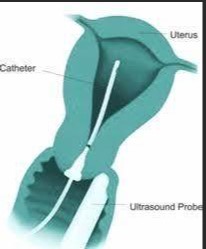What is sonohysterography (Ultrasound of the Uterus)?
Ultrasound imaging is a noninvasive medical test that helps physicians diagnose and treat medical conditions. It produces pictures of the inside of the body using sound waves. Ultrasound imaging is also called sonography. It uses a small probe called a transducer, and gel is placed between the transducer and the body. High-frequency sound waves travel from the probe through the gel into the body. The probe collects the sounds that bounce back. A computer uses those sound waves to create an image. Ultrasound exams do not use radiation (x-rays). Because ultrasound captures images in real time, it can show the structure and movement of the body’s internal organs. The images can also show blood flowing through blood vessels.
Sonohysterography, also known as saline infusion sonography, is a special, minimally invasive ultrasound technique that provides pictures of the inside of the uterus.
What are some common uses of the procedure?
It is a valuable technique for evaluating unexplained vaginal bleeding that may be the result of uterine abnormalities such as:
- fibroids
- endometrial adhesions (or scarring)
- malignant lesions/masses
- congenital defects
- Polyps
Sonohysterography is also used to investigate uterine abnormalities in patients who experience infertility or multiple miscarriages.
How should I prepare?
Wear comfortable, loose-fitting clothing. You may need to remove all clothing and jewelry in the area to be examined.
You may need to change into a gown for the procedure.
It is best to perform sonohysterography (hysterosonography) immediately after your period and within 10 days after the first day of your period to minimize the risk of infection and unintended loss of a very early pregnancy. At this time in the menstrual cycle, the endometrium is at its thinnest, which is the best time to determine if the endometrium is normal. However, the exam’s timing may vary depending on the symptoms and their suspected origins. Sonohysterography should not be performed if you are pregnant.
No special preparation is required prior to the exam. You may be advised to take an over-the-counter medication shortly before the procedure to minimize any potential discomfort.
